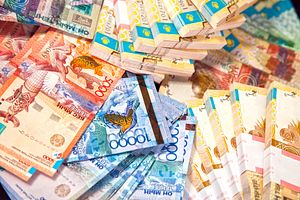This week, something of an historic meeting will take place in Washington. For the first time, as the U.S. Chamber of Commerce notes, “cabinet-level ministers from all five Central Asian nations will come together to engage the wider community of US businesses” via a “cultural reception” at the Chamber. The gathering will dovetail from a joint meeting with U.S. Secretary of State John Kerry, coming under the auspices of the C5+1 platform.
All told–and, most especially, from an economic perspective–the meeting can’t come quickly enough. While much of Washington’s regional relations hinge on security, there’s a non-negligible economic relationship that, over the past two years, has significantly flagged. While much has to do with the economic crunch roiling the region, Central Asia’s overall trade with the United States has taken a severe hit – with little signs of recovery on the horizon.
A quick glance at the United States’ foreign export and import numbers shine some light on how steeply trade between Washington and the region has dropped. All told, every Central Asian country – mirroring trade with China and Russia, likewise – saw a sudden decline in 2015. If preliminary numbers are indicative, only one nation, Kazakhstan, shows any signs of recovery in both export and import terms. Indeed, Astana’s resurgence–with U.S. total 2016 exports projected at over $1 billion based on the pace set in the first five months of 2016, surpassing 2014’s pace–is much more surprising given the country’s lurch toward recession. While American imports from Kazakhstan are currently projected at their lowest since 2004, and only about half their 2014 total, they’ve nearly recovered to 2015’s pace.
However lethargic Kazakhstan’s numbers may be, they appear the brightest glimmer of hope with regard to regional trade with Washington. The only other bit of good news, based on U.S. data, comes out of imports from Uzbekistan. Projected at nearly $60 million, these imports haven’t been this substantial since 2010. Still, those figures are offset by the collapse in U.S. exports to Uzbekistan, which are now projected at their lowest rate in a decade.
For the remaining three Central Asian countries, numbers are even more dire. In Kyrgyzstan, for instance, Washington is looking at the lowest annual exports – projected at $16.8 million, down from $145.5 million in 2012 – since 1994. Turkmenistan, likewise, has seen a sheer collapse in U.S. exports to Ashgabat, dropping nearly 90 percent from 2014 through 2016’s project rate, while imports from Turkmenistan are coming in at their lowest pace since 1999. Lastly Tajikistan, which is on pace to send only $720,000 worth of goods to the United States this year, looks like it will register the lowest pace of U.S. goods transited to Dushanbe since 1992 – or about one-twentieth what 2014 saw.
Taken together, the numbers are, in a sense, unsurprising, given both the region’s proximity to other (more) major trade partners, to say nothing of the overwhelming difficulty Central Asia presents regarding inter-regional trade. But this data also displays a reality that a quick tete-a-tete at the Chamber of Commerce will do little to change. Given the region’s economic forecast, Washington may want to get used to the downbeat numbers for the foreseeable future.
Clarification: As former Deputy Assistant Secretary of State for Central Asia Evan Feigenbaum notes, today’s meeting is not the first joint ministerial-level gathering yet seen. Such meetings have prior taken place under the rubric of the Trade and Investment Framework Agreement (TIFA) Council.

































